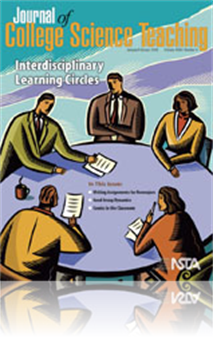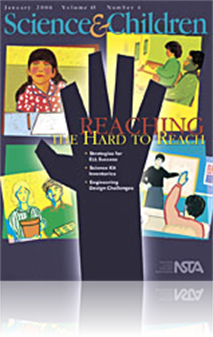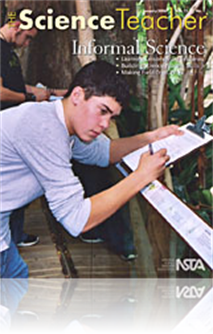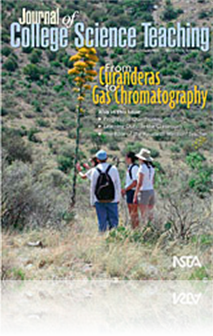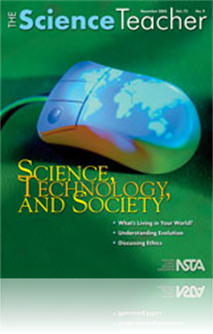All Resources
Journal Article
Science Sampler: Correcting student misconceptions
Before learning any formal science, children try to make sense of natural phenomena on their own. However, several studies have shown that it can be difficult to convince a student to give up a long-held misconception in favor of an accurate scientif...
Journal Article
The most important biochemical reactions for life in the ocean and on Earth are cellular respiration and photosynthesis. These two reactions play a central role in the carbon cycle. The ocean-based carbon cycle is highly relevant to today's students ...
Journal Article
The Case Study: Opening Day -- Getting Started in a Cooperative Classroom
What happens during the first few days of a new course can set a tone that inspires students to work actively and cooperatively to achieve success in the new semester. One professer figured out a way to motivate his organic chemistry class by begin...
Journal Article
Favorite Demonstration: Interactive Demonstrations -- Examples From Biology Lectures
Demonstrations have long been a part of postsecondary science teaching. However, in today's constructivist classroom we know that to show completely, we must actively involve students in their learning. This need for active student involvement exte...
Journal Article
Methods and Strategies: A New Use for Semantic Maps
Semantic maps are frequently used graphic organizers that help students analyze their reading or develop their vocabulary. However, semantic maps can also be used effectively as a preassessment strategy for science teaching....
Journal Article
Science Teaching beyond the Classroom
Informal learning and the environments where it takes place has the power to inspire our future aspirations, or evoke fond memories of childhood learning experiences. Museums, zoos, aquariums, parks, science centers, planetariums, the school yard, an...
Journal Article
Science for Fun? Try a High School Science Club!
Unravel the mysteries, intricacies, and delights of science by starting a high school science club in your school. Through a school science club, students develop teamwork, communication, and leadership skills. This article addresses the positive imp...
Journal Article
The Early Years: The Matter of Melting
This month's Early Years column reveals how establishing a shared language through experiences can help young students and teachers exchange ideas and information about science concepts. The experiences that occur as part of this month's activity ex...
Journal Article
The Use of Triangulation Methods in Qualitative Educational Research
Triangulation involves the careful reviewing of data collected through different methods in order to achieve a more accurate and valid estimate of qualitative results for a particular construct. This paper describes how we used three qualitative meth...
Journal Article
From Curanderas to Gas Chromatography: Medicinal Plants
The Medicinal Plants of the Southwest summer workshop is an inquiry-based learning approach to increase interest and skills in biomedical research. Working in teams, Hispanic and Native American students discover the chemical and biological basis for...
Journal Article
Waves on the Fly: Encouraging Inquiry in the Physics Classroom
Developing inquiry-based labs can seem pretty overwhelming, especially if you are new to the process. The secret is in the environment--when students feel comfortable asking questions and are encouraged to work together to find the answers, inquiry a...
Journal Article
Commentary: Valuing Informal Science Learning Environments
Understanding the spark that museums and science centers ignite for a continuum of learners helps teachers to think more creatively about engaging students in the classroom and challenges them to consider the power that authentic discovery plays in ...
Journal Article
Tried and true: Heating up inquiry with solar ovens
Melt away your students' fear of failure while igniting their scientific inquiry skills with this exciting and hands-on project using solar ovens. Students will design, build, and test a solar oven that is capable of making a smores treat....
Journal Article
Printed Notes Versus Virtual Lectures: An Examination of Student Learning of Geoscience Content
Two geoscience course sections were provided with lecture content in different formats—one with static text that contained no graphics, the other with a link to a virtual lecture. Follow-up quizzes showed no difference in learning between the two s...
Journal Article
Tech Trek: An e-learning science fair
Traditional science fairs have been replaced by having students use sophisticated technology to participate in a virtual science fair that relies on the internet, e-mail, and other tools of the digital age. The new E-Learning Science Fair (ELSF) was ...
Journal Article
Science Sampler: Capitalizing on student travel in Earth science classrooms
Students who take extended vacations during the school year can present a recurring challenge for educators. However, this article outlines creative strategies that will enrich students as they travel abroad, and engage them in the process of inquiry...
Journal Article
On Dinosaur Day, first-grade students rotated through four dinosaur-related learning stations that integrated science content with art, language arts, math, and history in a fun and time-efficient manner. The event drew parents, teachers, and student...
Journal Article
Learning Lessons from Estuaries
There is something that draws us all to the sea and especially to the fertile estuaries that nuzzle up to its shores. An estuary serves as both a nursery and a grave for sea creatures. This article describes annual trips to three islands in the Chesa...
Journal Article
A science kit inventory introduces students to tools and vocabulary, paving the way for successful science experiences. While it is an effective strategy for all students, it is especially useful for English Learners. This article describes how kit i...
Journal Article
A Partnership for Problem-Based Learning
So many demands are placed on high school teachers today. But the right kind of professional development can help teachers meet these challenges. A partnership among a high school biology teacher, a graduate student, and an assistant professor of bio...
Journal Article
Career of the Month: Historical Archaeologist
Historical archaeologists such as Mark Warner investigate through excavations and written records of how people lived in the recent past. This thrilling career involves the excavation of artifacts, in combination with written documents, and enables a...
Journal Article
Using an Authentic Radioisotope to Teach Half-Life
Traditionally, nuclear chemistry appears in the last few chapters of chemistry textbooks and is not normally considered a mainstream topic. Yet nuclear chemistry is a very important topic that should be taught in all chemistry classrooms. Today's tec...
Journal Article
Editor's Corner: Why is This Important?
When interconnections among science, technology, and society are made part of science teaching, we empower students with skills that allow them to become responsible, and thoughtful citizens. The articles in this issue of The Science Teacher provide ...
Journal Article
Finding innovative ways to teach 10th grade physical science students about the properties of the states of matter--as stated in the Physical Science Standards for Levels 9-12--can be a difficult task. To address this challenge, the author discovered...
Journal Article
Ask the Experts -- December 2005
The Experts give their "spin" on physical science concepts as they answer the question, "What does "spin" refer to in particle physics? Why is this concept necessary?" and "My physics teacher tells me that when I go around a sharp curve in my car, th...
Journal Article
Designing Project-Enhanced Environments
The concept of waves is fundamental due to its occurrence throughout the natural world (water, sound, and electromagnetic waves). Because the concept occurs in so many places, high school students come to the classroom with prior knowledge and miscon...
Journal Article
How to Have a Successful Science and Ethics Discussion
Students often come to class discussions with preformed opinions on many ethical issues. The challenging task for teachers is to help students learn to identify the facts of a case, recognize the underlying ethical dilemmas, and to understand the dif...




